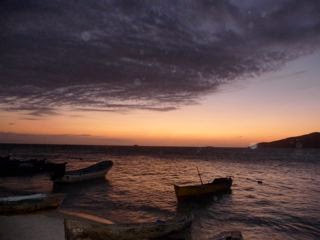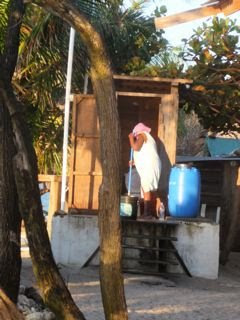I think it's spring - at least according to the calendar. Not according to parts of the midwest that have been hit with snowstorms - glad I'm missing that! We're past the rainy season here and have definitely left the cooler temperatures behind. The winds are beginning to shift back around to the east, to our sorrow, since our deck faces west. This is our first time to be here in late March and we've noticed that just this week, along with the hotter temperatures, there is a haziness early in the morning and again late in the day which we've never observed before. Some mornings the ocean view is obscured by this haze and yet, looking up, the sky is clear. The sunsets have also been hazy and are not as pretty as when there are some clouds to add interesting depth and color to the sky. We have been spoiled, haven't we?
I'm constantly noticing some plant or tree or flower that I've never really seen before. The trees down our hill are all blooming, some are purple, some pink and some appear to be white. I think some of these are what Merlin calls samwood trees. The woodpeckers really like them for some reason, seems to be their favorite tree.
I was just lamenting how frustrating it can be in trying to take care of business here, always seems to require 2 or 3 or more tries. For example, we bought paint for the interior walls, painted and realized it was dreadful, watery, streaky paint. So back we go to the paint store, shell out another $70. for 2 gallons of paint. Luckily, the paint mixer guy realized that he had mixed the wrong color before we left the store, or that would have been another trip back.
This week's agenda includes getting new 90-day visas and getting a new electric meter. We already had one try for each of those and got nothing much accomplished. Dennis and Merlin went with us to RECO, the electric company, so Merlin could translate and explain what was needed. It took Merlin a long time to explain to the office girl and even longer for her to actually understand. We have an electric meter and service to our house, of course, but the meter is in Merlin's name, the bill comes out in her name, but we pay for it. They need to get a another meter for their newest house, so - get this - apparently they cannot have another meter in their name, so we have to get one in our name and have it installed and give them back the one we've been using! They already have at least 6 meters for various houses on this hill. I can't imagine why we can't keep our meter, change the name on the account, buy a new meter and give it to them. That makes sense to me, but apparently only to me. So, in order to do this, RECO must come out and do a visual inspection, then we need to give them a copy of the signed paperwork from when we bought the property from Merlin and 1900 lempiras, then, assuming they don't think of some other silly obstacle, RECO will come out and change the meters. Oh yeah, and don't miss the part about how we have to buy the meter. It could be worse - Dennis and Merlin also had to buy the transformers! So, tomorrow we'll go back to RECO after we make certain that the inspection happened today. Then we'll deal with the visas.


















































